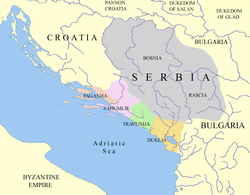Catepanate of Ras
| κατεπανίκιον Σερβλίας Катепанат Рас | |||||
| Principality of Serbia (fl. 600–971) Catepanate of Ras (971–976) Theme of Sirmium (1018–1071) Dukja (Zeta) (11th–12th century) Grand Principality of Serbia (1071–1217) Byzantine Empire Administrative Unit of Byzantine Empire | |||||
| |||||
 | |||||
| Capital | Stari Ras | ||||
| Government | Catepanate | ||||
| Historical era | Middle Ages | ||||
| • | Annexation | 971 | |||
| • | Disestablished | 976 | |||
The Catepanate of Ras Greek: κατεπανίκιον Σερβλίας) was a Byzantine province established between 971–976 in Serbia, during the rule of John Tzimiskes (r. 969–976).[1][2]
The name of the Catepanate was derived from the name of the fortified town of Ras in the Serbian region of (Raška) or lat. Rascia. The earliest possible date of its creation is 971, when victorious Byzantine armies conquered Bulgaria and re-established Byzantine supreme rule over the interior of Southeast Europe. One of the newly formed administrative units was the Catepanate of Ras. The Catepanate was established as a Byzantine stronghold in Serbian lands, but its territorial jurisdiction can not be precisely determined.[3]
The sole primary source for the organization of the Catepanate is seal of a strategos of Ras, dated to the time of emperor John' reign.[4][5] The seal belonged to protospatharios and katepano of Ras named John, who is the only known holder of the office of Catepan of Ras.[6]
The Catepanate was short lived as the rest of the Byzantine rule in Bulgarian and Serbian lands, since after the death of emperor John (976) a successful uprising started in the nearby regions resulting, led by members of the Cometopuli dynasty.
References
- ↑ Ćirković 2004, p. 30.
- ↑ Bulić 2007, p. 45–62.
- ↑ The Byzantine province in change: on the threshold between the 10th and the 11th century. Institute for Byzantine Studies, Serbian Academy of Sciences and Arts. 2008. p. 189.
- ↑ Stephenson 2003, p. 42.
- ↑ Stephenson 2003a, p. 122.
- ↑ Byzantinoslavica. 65–66. Academia. 2007. p. 132.
Sources
- Vlasto, Alexis P. (1970). The entry of the Slavs into Christendom. Cambridge University Press.
- Stephenson, Paul (2003). The Legend of Basil the Bulgar-slayer. Cambridge University Press.
- Stephenson, Paul (2003a). "The Balkan Frontier in the Year 1000". Byzantium in the year 1000. BRILL. pp. 109–134.
- Bulić, Dejan (2007). "Gradina-Kazanoviće, results of archeological research". Istorijski časopis (55): 45–62.
- Ćirković, Sima (2004). The Serbs. Malden: Blackwell Publishing.
- "The Holy Virgin of Ljeviska, Bogdorica Ljeviska" (PDF). Cultural Corridors of South East Europe.